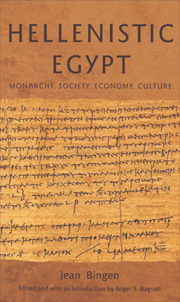Book contents
- Frontmatter
- Contents
- Original Sources of Chapters
- List of illustrations
- Glossary
- Maps
- Foreword
- Introduction: Jean Bingen and the currents of Ptolemaic history
- Part I The Monarchy
- Part II The Greeks
- 6 The Thracians in Ptolemaic Egypt
- 7 Ptolemaic papyri and the Achaean diaspora in Hellenistic Egypt
- 8 Greek presence and the Ptolemaic rural setting
- 9 The urban milieu in the Egyptian countryside during the Ptolemaic period
- 10 Kerkeosiris and its Greeks in the second century
- 11 The cavalry settlers of the Herakleopolite in the first century
- 12 Two royal ordinances of the first century and the Alexandrians
- Part III The Royal Economy
- Part IV Greeks and Egyptians
- Conclusion
- Bibliography
- General index
- Index of passages discussed
- HELLENISTIC CULTURE AND SOCIETY
7 - Ptolemaic papyri and the Achaean diaspora in Hellenistic Egypt
from Part II - The Greeks
- Frontmatter
- Contents
- Original Sources of Chapters
- List of illustrations
- Glossary
- Maps
- Foreword
- Introduction: Jean Bingen and the currents of Ptolemaic history
- Part I The Monarchy
- Part II The Greeks
- 6 The Thracians in Ptolemaic Egypt
- 7 Ptolemaic papyri and the Achaean diaspora in Hellenistic Egypt
- 8 Greek presence and the Ptolemaic rural setting
- 9 The urban milieu in the Egyptian countryside during the Ptolemaic period
- 10 Kerkeosiris and its Greeks in the second century
- 11 The cavalry settlers of the Herakleopolite in the first century
- 12 Two royal ordinances of the first century and the Alexandrians
- Part III The Royal Economy
- Part IV Greeks and Egyptians
- Conclusion
- Bibliography
- General index
- Index of passages discussed
- HELLENISTIC CULTURE AND SOCIETY
Summary
Achaea holds only a modest rank among the countries which supplied immigrants to Egypt in the Ptolemaic period. This is even more true of neighbouring Elis (see the appendix to this chapter). Few papyri and inscriptions from Alexandria or the Nile valley in that period testify that an individual is a native of Achaea or descended from an Achaean immigrant. Such examples are, however, precious material for an eventual prosopography of Hellenistic Achaea. Still, one cannot hope to find in so reduced a sample significant help for a type of research which attracted my attention, the differential study of the ethnic constituents of Hellenistic Egypt.
I shall retain here as a general frame for this chapter the immigrants that the administration of the Ptolemies called more or less officially, but in fact very rarely, Hellênes, a term which is much more complex than one could believe at first sight. In a papyrological dossier from the third century bc in the Vienna collection,3 the epithet Hellênes applies to a group with a particular fiscal status, members of which have not only Macedonian or Greek names, but also Thracian and Jewish ones. They live in a village in the Fayyum and are in fact more or less active elements of the Alexandrian royal system on the military, administrative or economic level. Roughly, in this document, the Hellênes are simply everyone who is ‘not autochthonous’.
- Type
- Chapter
- Information
- Hellenistic EgyptMonarchy, Society, Economy, Culture, pp. 94 - 103Publisher: Edinburgh University PressPrint publication year: 2007

